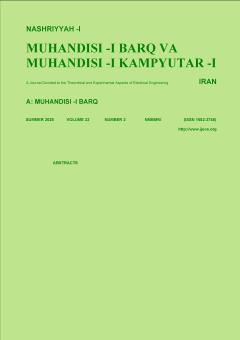About the journal
Recent Articles
-
Open Access Article
1 - A Comprehensive Review of the Synthesis of Linear and Planar Antenna Arrays
A. Pesarakloo * ، M. Khalaj-AmirhosseiniIssue 2 , Vol. 23 , Summer 2025 -
Open Access Article
2 - Performance Analysis of Different Control Methods in Permanent Magnet Synchronous Motor Drives: A Comparative Study
M. Salmanfar ، A. Dehestani Kolagar * ، Mohammad Reza Alizadeh Pahlavani ، Yousef KoohmaskaIssue 2 , Vol. 23 , Summer 2025 -
Open Access Article
3 - Design of a Power Electronic Transformer Structure Based on Multi-Port Converters with Integrated Energy Storage Capability
H. Kavosh ، M. Saradarzadeh *Issue 2 , Vol. 23 , Summer 2025 -
Open Access Article
4 - Modeling Transient Time-Dependent Behavior of a Digital Phase-Locked Loop Circuit Using Gated Recurrent Neural Network
S. F. Mousavi ، S. A. Sadrossadat ، A. Moftakharzadeh *Issue 2 , Vol. 23 , Summer 2025 -
Open Access Article
5 - Enhanced Automatic Test Pattern Generation Using PSO-FAN Algorithm
S. H. Zahiri * ، Ehsan Haghparast ، Abolfazl BijariIssue 2 , Vol. 23 , Summer 2025 -
Open Access Article
6 - A New Active Impedance Source Inverter with Reduced Voltage Stress Across the Switches
V. Ranjbarizad ، E. Babaei *Issue 2 , Vol. 23 , Summer 2025
Most Viewed Articles
-
Open Access Article
1 - Experimental Modeling of Two-Dimensional Systems with ARMA Structure
M. sadabadi ، M. shafiee ، M. karrariIssue 1 , Vol. 7 , Spring 2009 -
Open Access Article
2 - Designing an Optimal Proportional-Integral Sliding Surface for a Quarter Car Active Suspension System with Suspension Components Possessing Uncertain Constants and Nonlinear Characteristics
S. A. Zahiripour ، A. A. Jalali *Issue 3 , Vol. 10 , Autumn 2012 -
Open Access Article
3 - A Novel Link Prediction Approach on Social Networks
S. Rezavandi Shoaii ، H. Zare *Issue 3 , Vol. 16 , Autumn 2021 -
Open Access Article
4 - Reactive Power Management in the Presence of Wind Turbine Considering Uncertainty of Load and Generation
E. Moharamy ، S. Esmaeili *Issue 3 , Vol. 13 , Autumn 2015 -
Open Access Article
5 - Modeling of K-250 Compressor Using NARX and Hierarchical Fuzzy Model
Adel Khosravi ، Abbas Chatraei ، G. Shahgholian * ، Seyed-Mohamad KargarIssue 3 , Vol. 18 , Autumn 2020 -
Open Access Article
6 - Proposing a Density-Based Clustering Algorithm with Ability to Discover Multi-Density Clusters in Spatial Databases
A. Zadedehbalaei * ، A. Bagheri ، H. AfsharIssue 3 , Vol. 15 , Autumn 2017 -
Open Access Article
7 - Modeling and Reliability Evaluation of Magnetically Controlled Reactor based on the Markov Process Technique
M. Haghshenas ، R. Hooshmand *Issue 3 , Vol. 17 , Autumn 2019 -
Open Access Article
8 - Design and Analysis of a Novel Robust and Fast Sliding-Mode Control with Multi-Slope Sliding Surface for Single-Phase Three Level NPC Inverters under Different Loads and Reduce the Output THD
B. Khajeh-Shalaly ، G. Shahgholian *Issue 2 , Vol. 15 , Summer 2017 -
Open Access Article
9 - Automatic Reference Image Selecting for Histogram Matching in Image Enhancement
N. Samadiani * ، H. HassanpourIssue 2 , Vol. 13 , Summer 2015 -
Open Access Article
10 - Traffic Patterns Detection in Video Surveillance Using Optical Flow and Topic Model
Amin Moradi ، Asadollah Shahbahrami * ، Alireza AkoshidehIssue 3 , Vol. 18 , Autumn 2020





